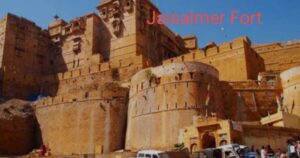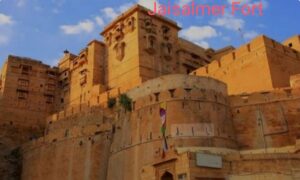Jaisalmer Fort, an imposing structure rising from the golden sands of the Thar Desert, stands as a testament to the grandeur and opulence of Rajasthan’s architectural heritage. Often referred to as the “Golden Fort” due to its yellow sandstone walls that gleam in the sunlight, this fort is a marvel of medieval engineering and design. Recognized as a UNESCO World Heritage Site, Jaisalmer Fort is not only a historical monument but also a living fort, with a quarter of the old city’s population still residing within its walls.

1.Jaisalmer Fort: Historical Background
The foundation of Jaisalmer Fort was laid by Rawal Jaisal, a Bhati Rajput ruler, in 1156 AD. Strategically located on the ancient Silk Route, the fort served as a crucial trade hub, linking India with Persia, Arabia, Egypt, and the West. Over the centuries, Jaisalmer Fort witnessed numerous battles and sieges, enduring the test of time and the onslaught of various rulers. The fort’s rich history is marked by tales of valor, sacrifice, and the unyielding spirit of its defenders.
2. Jaisalmer Fort: Architectural Marvel
Jaisalmer Fort’s architecture is a blend of Islamic and Rajput styles, characterized by intricate carvings, ornate balconies, and beautifully designed windows. Constructed from golden-yellow sandstone, the fort appears to change color with the movement of the sun, giving it a mesmerizing aura. The fort complex encompasses numerous structures, including palaces, havelis (mansions), temples, and residential buildings, all showcasing exquisite craftsmanship.

3. Jaisalmer Fort: Key Attractions within the Fort
– Raj Mahal (Royal Palace): Once the residence of the rulers of Jaisalmer, the Raj Mahal is a splendid example of royal architecture. It houses several rooms adorned with murals, mirror work, and intricate carvings.
– Jain Temples:The fort is home to seven beautifully carved Jain temples built between the 12th and 16th centuries. These temples, dedicated to various Tirthankaras, are renowned for their stunning architecture and intricate marble work.
– Laxminath Temple: This Hindu temple, dedicated to the deities Vishnu and Lakshmi, is one of the oldest temples within the fort and reflects the harmonious coexistence of different religions in the region.
– Fortified Walls and Gates: The fort’s massive walls and four fortified gates (Khai Pol, Ganesh Pol, Suraj Pol, and Hawa Pol) are formidable structures that have withstood numerous invasions. Walking through these gates, visitors can feel the historical significance and the fort’s strategic importance.
4.Jaisalmer Fort: Cultural Significance
Jaisalmer Fort is not just a monument of the past; it is a vibrant center of local culture and traditions. The fort comes alive during various festivals and events, such as the Desert Festival, where traditional music, dance, and camel races captivate visitors. The influence of Rajput culture is evident in the fort’s architecture, arts, and daily life of the residents, making it a living museum of Rajasthan’s heritage.
5. Tourism and Visitor Experience
Visiting Jaisalmer Fort is a journey back in time, offering a unique glimpse into the rich history and culture of Rajasthan. The best time to visit is during the cooler months from October to March. Guided tours are available, providing insights into the fort’s history, architecture, and significance. Within the fort, visitors can explore quaint shops selling local handicrafts, textiles, and jewelry, and enjoy traditional Rajasthani cuisine at various eateries. Nearby attractions include the Sam Sand Dunes, Jagadish Lake, and the Paton Ki Haveli, enhancing the overall visitor experience.
6. Preservation Efforts
Preserving Jaisalmer Fort is a challenging task due to natural wear and tear, and the pressures of tourism. Various conservation initiatives have been undertaken by the government and non-governmental organizations to restore and maintain the fort’s structural integrity. Sustainable tourism practices are being promoted to ensure that the fort’s beauty and historical significance are preserved for future generations.
Conclusion:
Jaisalmer Fort, with its rich history, architectural splendor, and cultural vibrancy, is a jewel in the crown of Rajasthan’s heritage. As a major tourist attraction, it offers an unforgettable experience, transporting visitors to a bygone era of royalty and grandeur. It is imperative to continue efforts to preserve this magnificent fort, ensuring that it remains a symbol of India’s glorious past for generations to come. Whether you’re a history buff, an architecture enthusiast, or a traveler seeking new experiences, Jaisalmer Fort promises an enchanting journey through time.
FAQ:
1.Why is Jaisalmer Fort famous?
2.What’s inside the Jaisalmer Fort?
3.Why should I visit Jaisalmer Fort?
4.10 lines on Jaisalmer Fort
5.Jaisalmer fort height
6.Jaisalmer fort wikipedia
7.Jaisalmer fort built by
8.Why Jaisalmer Fort is famous
9.Jaisalmer Fort location


Pingback: Sinhagad Fort Pune: The Best Ultimate Trekking Destination Near the City - solotraveler